Luận án Electrospinning of α-Fe₂O₃ and ZnFe₂O₄ nanofibers loaded with reduced graphene oxide (RGO) for H₂S gas sensing application
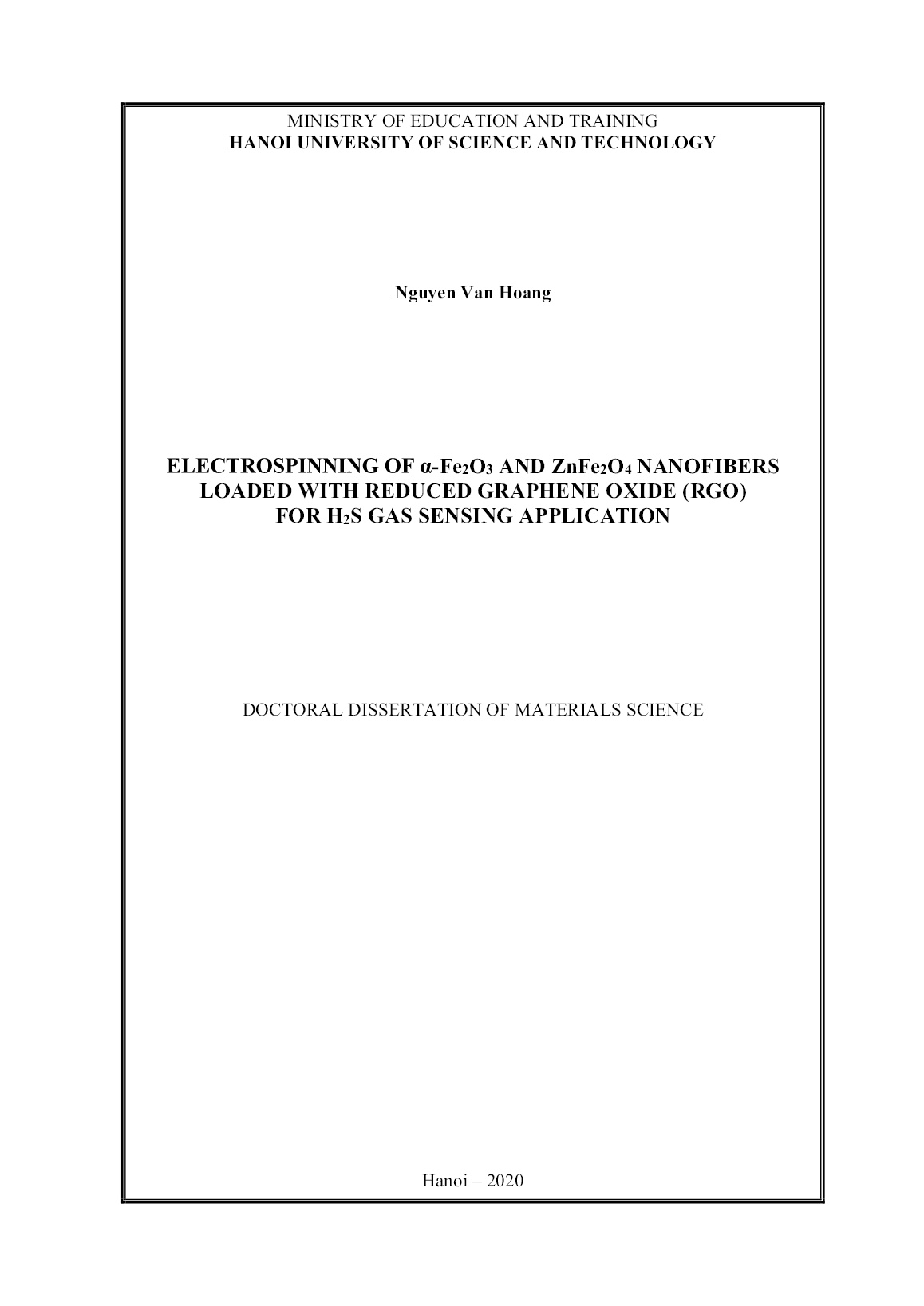
Trang 1
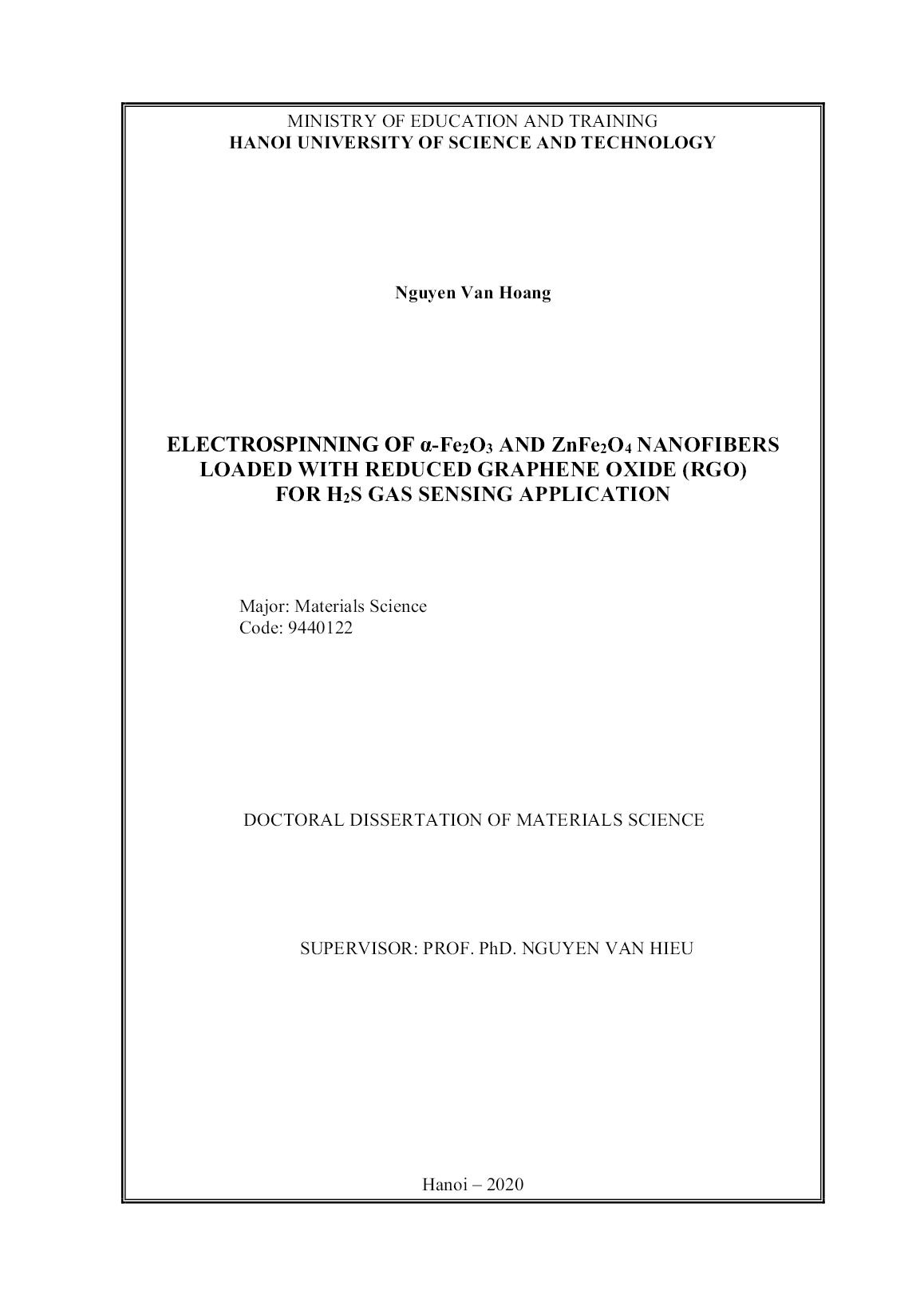
Trang 2
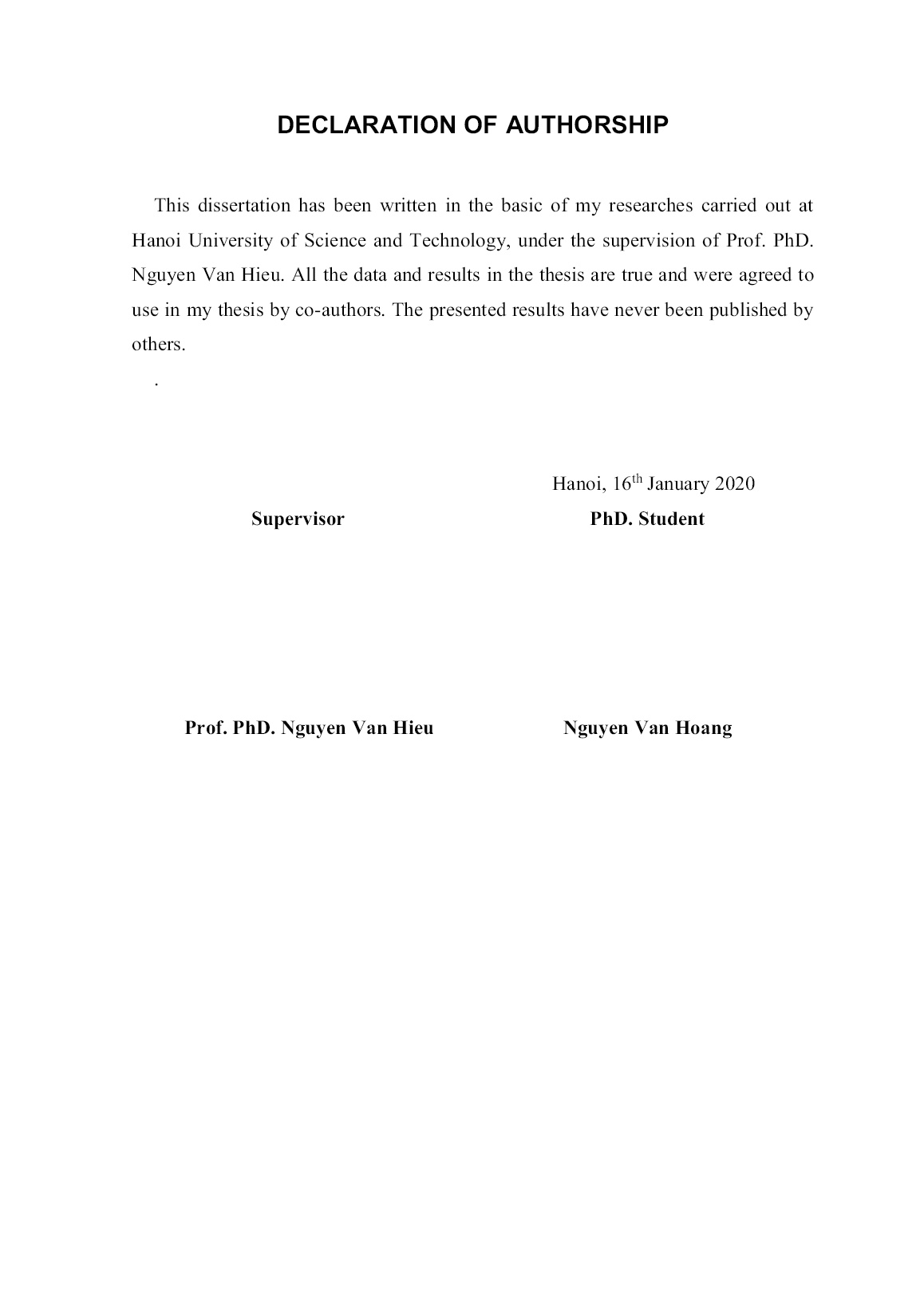
Trang 3

Trang 4
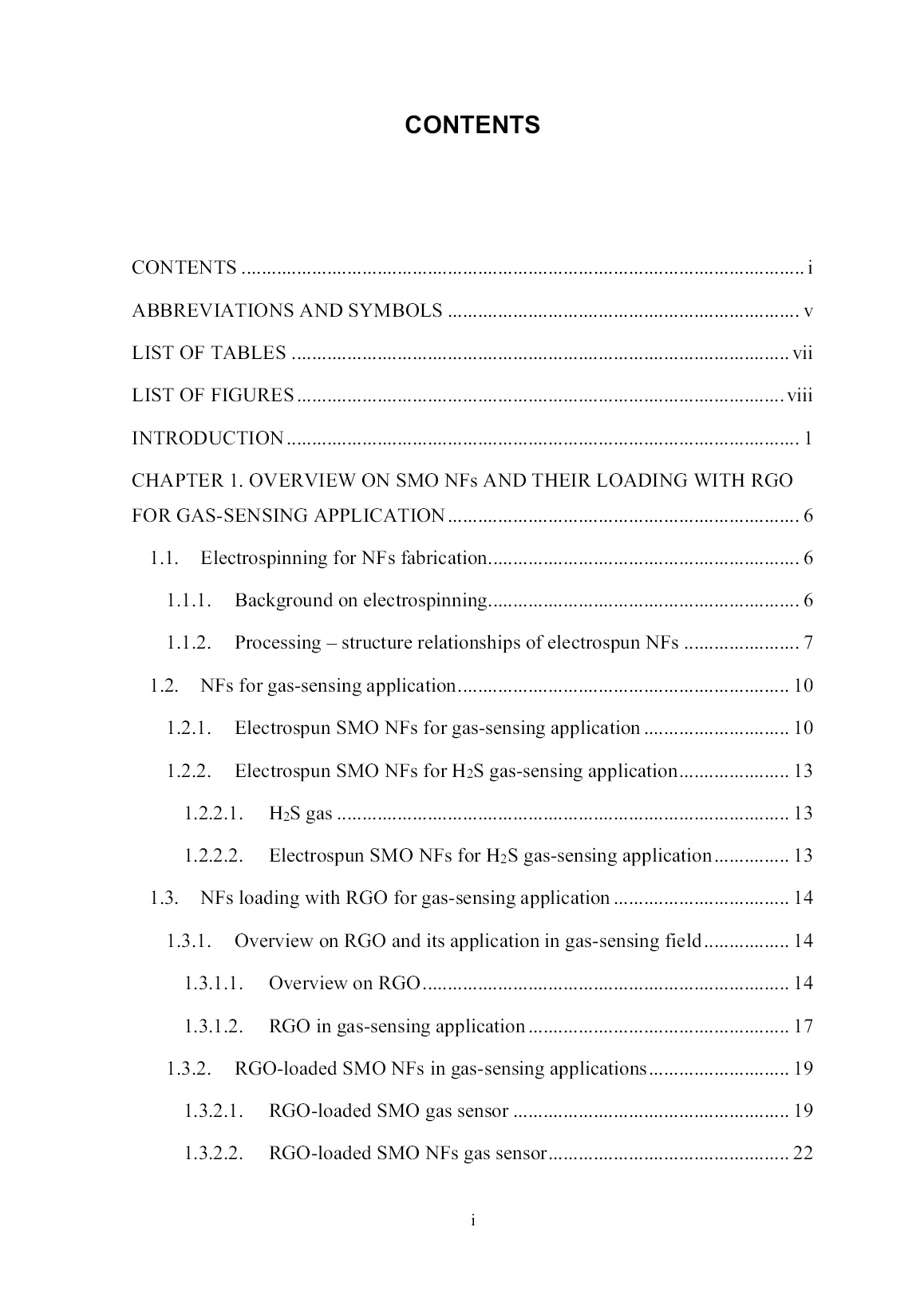
Trang 5
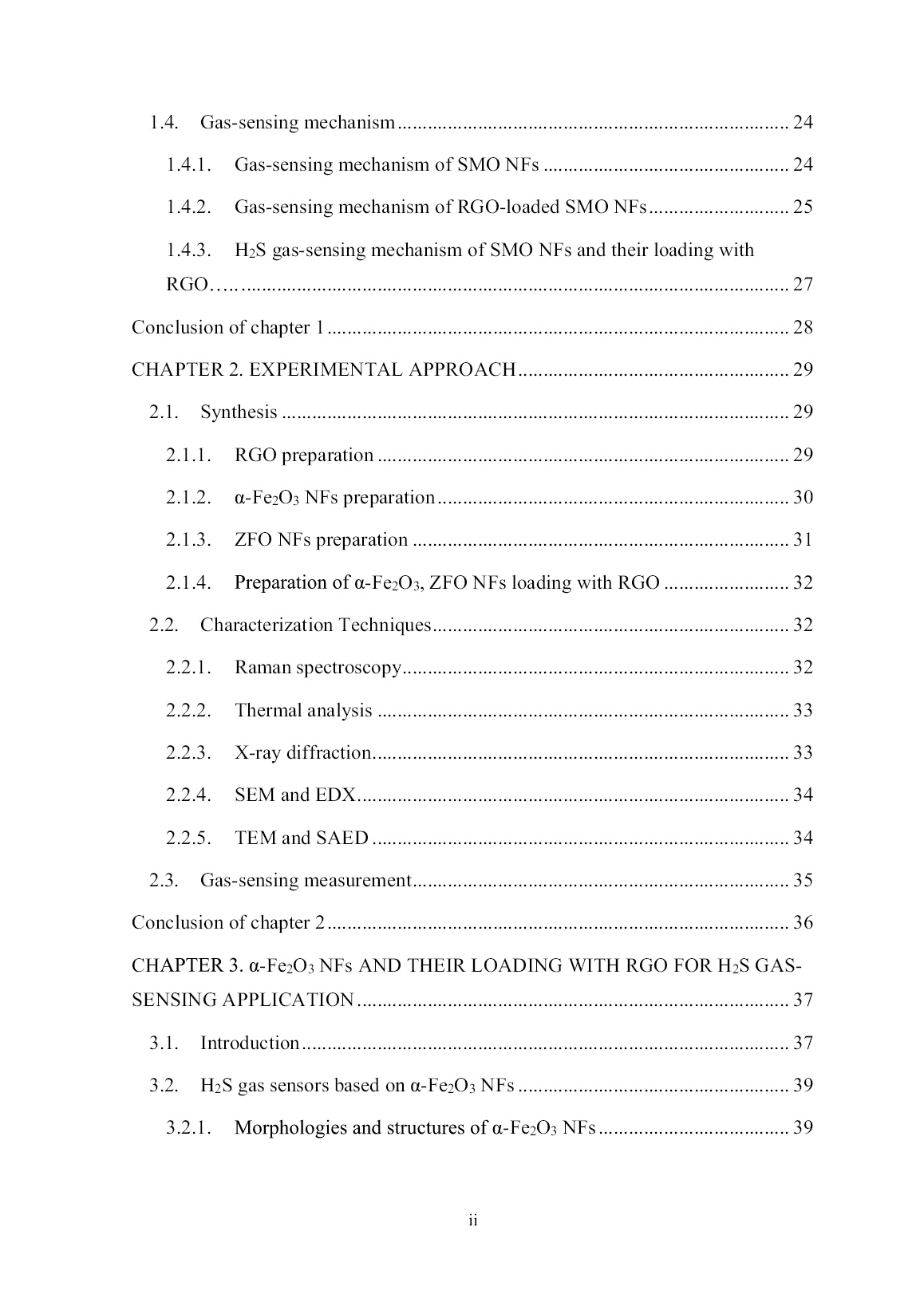
Trang 6
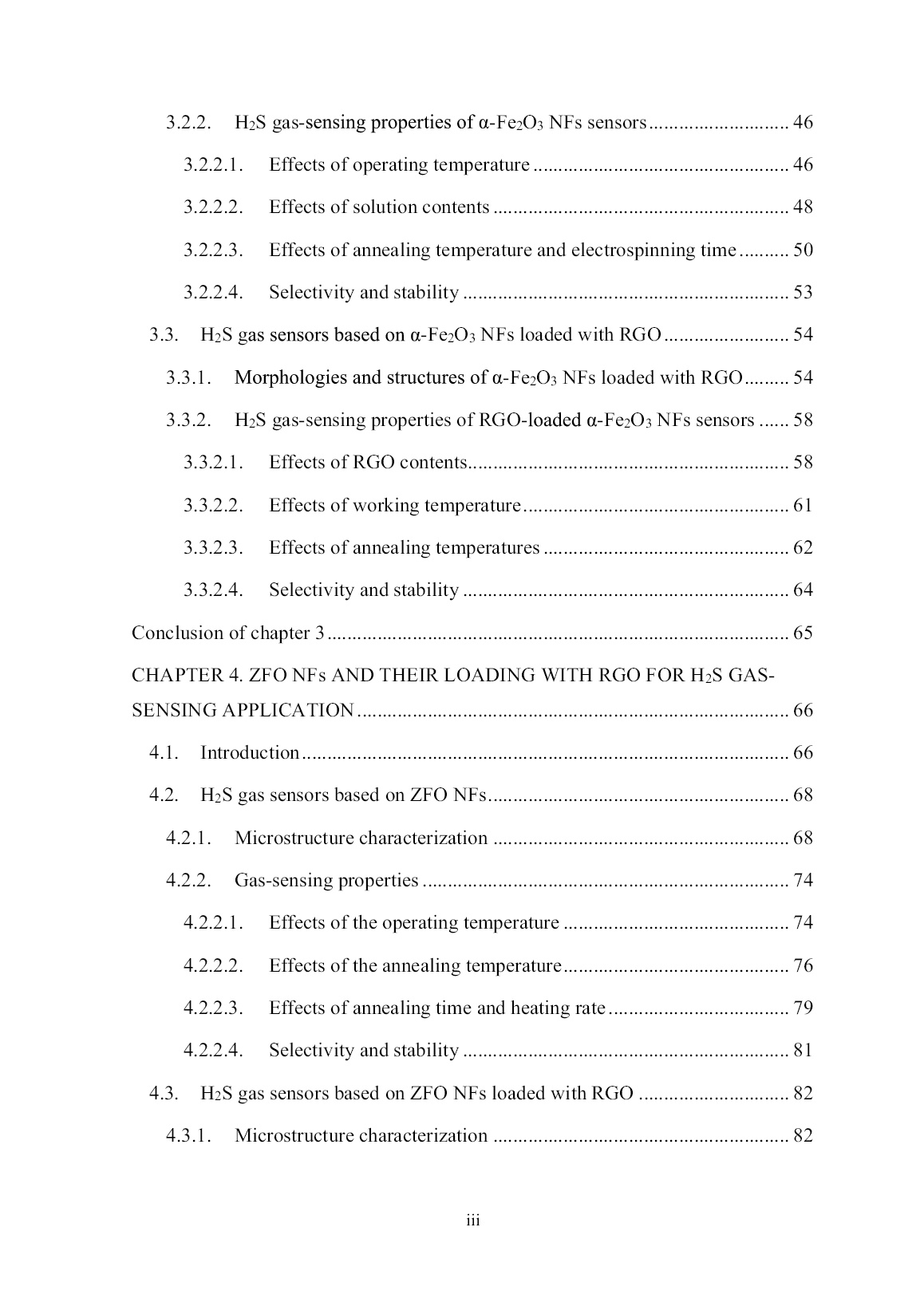
Trang 7
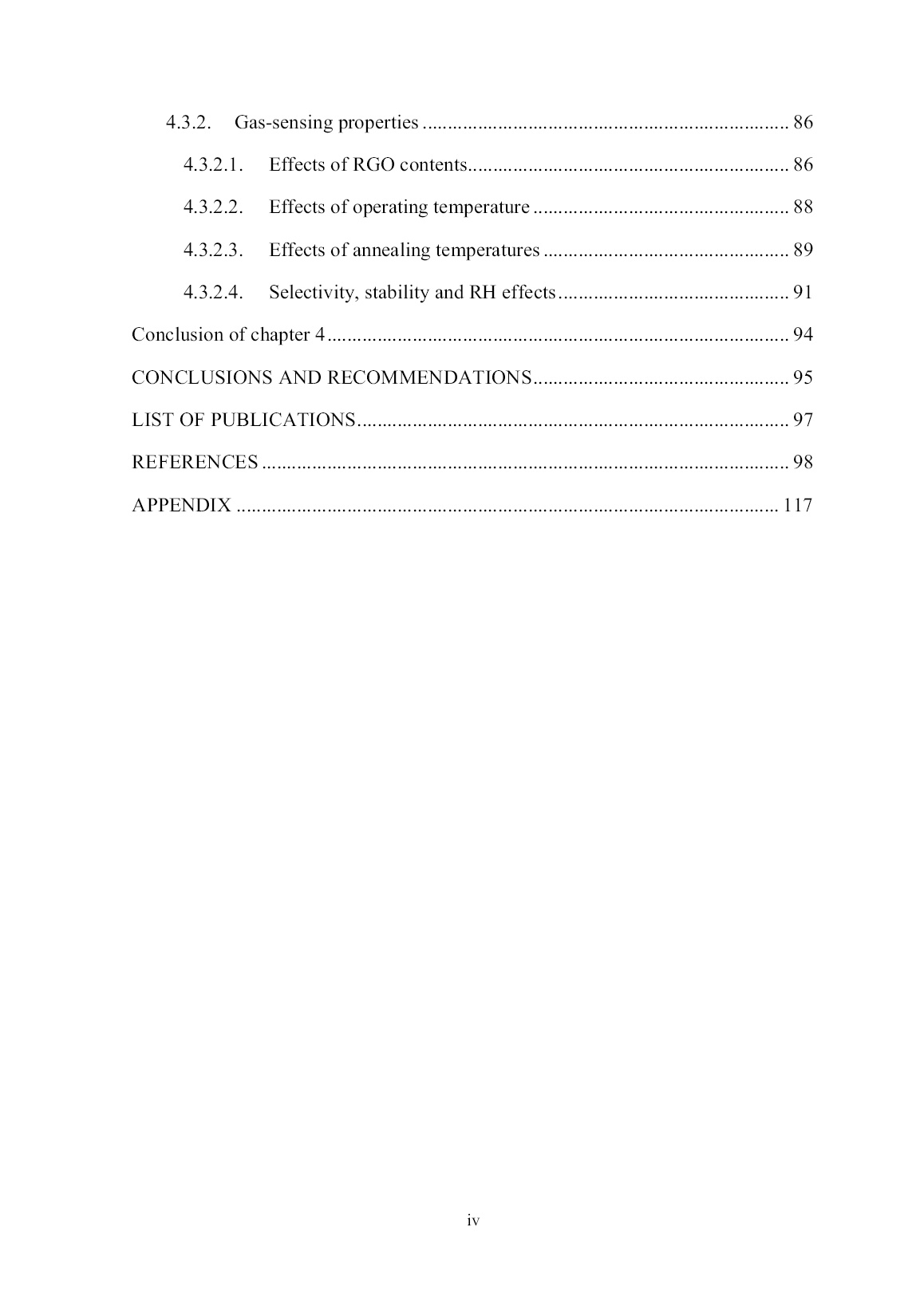
Trang 8
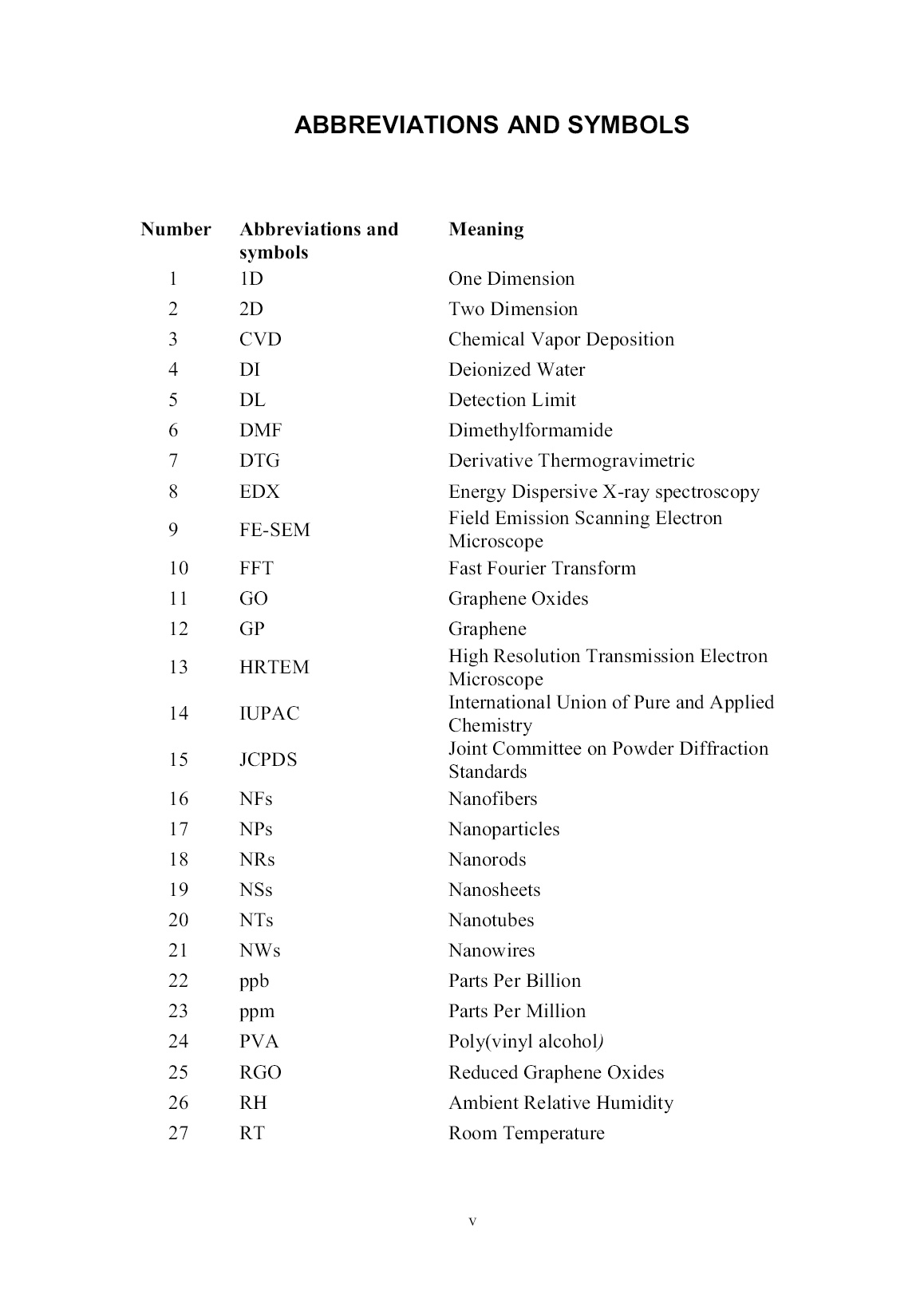
Trang 9
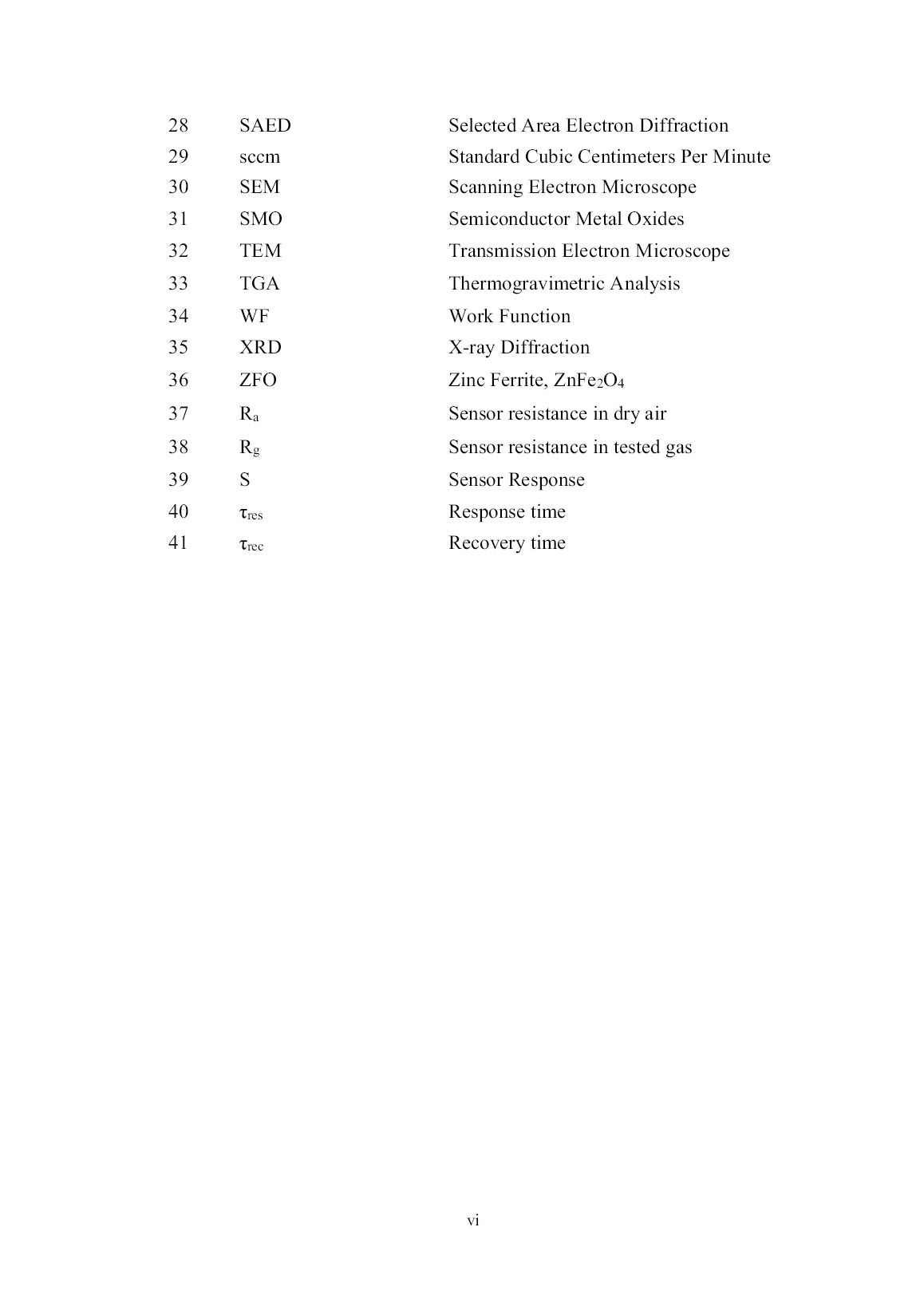
Trang 10
Tải về để xem bản đầy đủ
Bạn đang xem 10 trang mẫu của tài liệu "Luận án Electrospinning of α-Fe₂O₃ and ZnFe₂O₄ nanofibers loaded with reduced graphene oxide (RGO) for H₂S gas sensing application", để tải tài liệu gốc về máy hãy click vào nút Download ở trên.
Tóm tắt nội dung tài liệu: Luận án Electrospinning of α-Fe₂O₃ and ZnFe₂O₄ nanofibers loaded with reduced graphene oxide (RGO) for H₂S gas sensing application
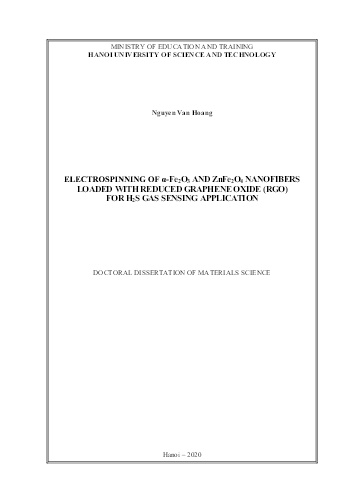
n the sensors were exposed to high temperature gases, and consequently reducing the sensor response. On the other hand, the increased working temperature also decreased the height of the potential barrier of homojunctions among nanograins at the grain boundaries, leading to a decrease in the sensor resistance. Therefore, the resistance modulation declined when the sensors were exposed to the reducing H2S and dry air. As a result, the sensor response sharply decreased with the increased working temperature from 250 to 450°C. However, the recovery time of α-Fe2O3 NFs sensor also became too long with the decreased working temperature, even thousands of seconds at the low working temperature of 250°C; meanwhile, the response time did not change much (Fig. 3.10d–e). The sensor recovery time decreased drastically when the working temperature was raised by increasing the rate of the reaction (1.1–1.2) in Section 1.4.3 and augmenting the rate of the diffusion process along the grain boundary. Therefore, in order to optimize the sensor response and recovery time, the working temperature of 350°C was selected to investigate gas-sensing properties of the α- Fe2O3 NFs sensors in the following section. 3.2.2.2. Effects of solution contents Fig. 3.11 showed the relation between precursor solution contents and the H2S Figure. 3.10. Schematic of the gas-sensing mechanism of the α-Fe2O3 NFs: in air (a) and in H2S gas (b). 49 gas-sensing properties of the α-Fe2O3 NFs sensors. The dynamic response curves to different concentrations of H2S at 350°C of the α-Fe2O3 NFs sensors with PVA concentrations (7–15 wt%), and various ferric salt compositions (2–8 wt%) were shown in Fig. 3.11a–c and Fig. 3.11d–f, respectively. When the sensor was exposed to H2S gas, the sensor resistance decreased, illustrating the typical response of n- type SMO to the reducing gas. The relation between PVA concentration and the sensor response with H2S concentration of 0.1–1 ppm at the operating temperature of 350°C is shown in Fig. 3.11g. In general, the higher the PVA concentration was, the lower the sensor response became. At 350°C and 1 ppm H2S, the sensor response decreased from 8.4 to 2.9 with increased PVA concentration between 7 and 15 wt %. However, with 7 % PVA concentration, the NFs comprised a network of small beads interconnected by thin fibers (Fig. 3.4a, d). Whereas, the NFs prepared from precursor solution with 11 wt% PVA showed the typical spider-net morphology with many round and uniform NFs fabricated by electrospinning as reported in many works [1,2,47,49,133]. Therefore, the sensor prepared from precursor solution with 11 wt% PVA was chosen for further study. The correlation between ferric salt concentrations in the precursor solution and H2S gas-sensing properties of the α-Fe2O3 NFs sensors was shown in Fig. 3.11h. When ferric salt concentration was increased from 2 to 8 wt%, the sensor response increased and reached the maximum, and then decreased. At the operating temperature of 350°C, the sensor response to 1 ppm H2S gas was 2 at 2 wt% and reached the maximum of 6.2 at 4 wt% and then went down to 4.9 with 8 wt% ferric salt. These results were possibly explained by the effects of morphologies and microstructures of synthesized NFs on their gas-sensing properties as mentioned in previous work [122]. Specifically, when PVA concentration increased, NFs diameters also went up and their surface-to-volume ratio decreased, leading to a decline in the sensor response. Otherwise, when the salt concentration was 2 wt%, the obtained NFs had a belt-like morphology with a large size and low porosity, therefore, the sensor response was quite low. If the salt concentration was increased 50 to 4 wt%, the NFs were uniform with a diameter of about 50 nm. Simultaneously, their surface-to-volume ratio and porosity were high, thus the sensor response reached the maximum value. When the salt concentration was further raised to 8 wt%, the NFs diameters became larger and their surface-to-volume ratio and porosity were low, leading to a decrease in the sensor response. 3.2.2.3. Effects of annealing temperature and electrospinning time The transient responses to H2S gas of the α-Fe2O3 sensors at different annealing temperatures (400–800°C) were presented in Fig. 3.12a–e. Accordingly, all dynamic curves exhibited the typical characteristics of an n-type SMO when the sensor was introduced to reducing gas H2S. The sensor response to different Figure 3.11. H2S sensing transients of α-Fe2O3 NF sensors with various PVA concentrations (a−c) and different ferric salt concentrations (d−f). Sensor response to H2S gas as a function of PVA concentrations (g) and ferric salt concentrations (h). 8 10 12 14 0 5 S ( R a /R g ) (g) 2.9 8.4 6.1 PVA Conc. (wt.%) @1 ppm @0.5 ppm @0.25 ppm @0.1 ppm 0 500 1000 1500 2000 0.1 1 1 50 100 Time (sec) @ 7 wt% PVA (c) R ( M ) @ 11 wt% PVA (b) 0.25 ppm 0.1 ppm 0.5 ppm @ 15 wt% PVA 1 ppm (a) 0 500 1000 1500 2000 1 2 3 4 5 1 0.01 0.1 Time (sec) @ 2 wt% Fe 3 (NO 3 ) 3 .9H 2 O (f) R ( M ) @ 4 wt% Fe 3 (NO 3 ) 3 .9H 2 O (e) 0.25 ppm 0.1 ppm 0.5 ppm @ 8 wt% Fe 3 (NO 3 ) 3 .9H 2 O 1 ppm (d) 2 4 6 8 0 5 (h) S ( R a /R g ) 2.0 4.9 6.1 Fe(NO 3 ) 3 .9H 2 O Conc. (wt.%) @1 ppm @0.5 ppm @0.25 ppm @0.1 ppm 51 concentrations H2S gas at working temperature of 350°C corresponding to annealing temperature was shown in Fig. 3.12k. When the annealing temperature increased from 400 to 500°C, the sensor response decreased. When the annealing temperature continued to rise to 600°C, the response increased. However, the response decreased sharply when the annealing temperature further increased to 800°C. The response modulation of α-Fe2O3 NFs sensors corresponding to changed annealing temperature could possibly be explained by the change in crystallinity and grain size of NFs with different annealing temperatures. According to many works, there were two opposite trends that affected the NFs sensor response when the annealing temperature was changed [47,49]. Accordingly, when the annealing Figure 3.12. H2S sensing transients of α-Fe2O3 NF sensors with various annealing temperatures (400−800°C) (a−e) and different electrospinning time (10−120 min) (f−i). Sensor response to H2S gas as a function of annealing temperatures (k) and electrospinning time (l). 52 temperature increased, the grain size got bigger and consequently, the number of grain boundaries decreased, leading to a decline in potential barriers among nanograins, resulting in a decrease in the sensor response; at the same time, the crystallinity of the NFs was also augmented, causing an increase in the sensor response. These two trends helped to clarify the response variation of α-Fe2O3 NFs sensors with the altered annealing temperature. When the temperature went down from 600 to 500°C, the response decreased due to the strong influence of decreased crystallinity. When the temperature further decreased from 500 to 400°C, the sensor response increased because of the strong effect of decreased grain size caused by decreased annealing temperature. Meanwhile, when the temperature increased from 600 to 800°C, the sensor response decreased remarkably because of grain growth at high annealing temperature. The highest sensor response obtained at optimal annealing temperature of 600°C. The sensor responses to 1 and 0.1 ppm H2S at working temperature of 350°C were 6.1 and 1.2, respectively. Most electrospun NFs sensors have been prepared by indirect methods. Accordingly, NFs were electrospun on Si or Al substrates [135,136], then dispersed in a solvent and deposited on desired substrates. In this study, the α-Fe2O3 NFs sensors were prepared by on-chip electrospinning for gas-sensing measurement. The density of the NFs on the microelectrode chip, which could be controlled by electrospinning time, strongly affected gas-sensing performance. Thus, the electrospun time of the on-chip NFs sensors was an important parameter that needed to be optimized for gas-sensing properties. As shown in Fig. 3.12f–i, the dynamic response curves of the α-Fe2O3 NFs sensors with various electrospinning time (10–120 min) exhibited a typical n-type characteristics of SMO. The gas responses as a function of electrospun time at working temperature of 350°C were shown in Fig. 3.12l. The gas response showed a bell-shape relation with electrospun time at working temperature of 350°C and the response peak was obtained at the electrospun time of 30 min. The NFs sensor response increased with increased electrospun time due to an increase in the NFs-NFs junctions between Pt electrodes. Such junctions improved the sensor sensitivity when the sensors were exposed to H2S gas [137,138]. The response decreased with the further increased electrospun 53 time. The sensor response depended on the reactivity and diffusion of gas molecules inside the gas-sensing layer [139,140]. Therefore, when the electrospun time increased, there was an increase in thickness of the sensing layer, resulting in a decrease in the response because of the increased gas diffusion length. Briefly, the α-Fe2O3 NFs sensor was calcined at 600°C and electrospun for 30 min with the precursor solution of 11 wt% PVA and 4 wt% Fe (NO3)3 salt for optimizing among structures, morphologies and sensor response. The selectivity and stability of this optimal sensor will continue to be studied in the next section. 3.2.2.4. Selectivity and stability It is well-known that selectivity and stability are important characteristics of gas sensors for practical applications. The selectivity of the α-Fe2O3 NFs sensor calcined at 600°C and electrospun for 30 min with the precursor solution of 11 wt% PVA and 4 wt% Fe (NO3)3 salt was tested with various gases such as SO2, NH3, and H2 gas at working temperature of 350°C. Fig. 3.13a showed that the sensor response gas reached 5.6 to 10 ppm SO2, 1.7 to 1000 ppm NH3, and 1.6 to 1000 ppm H2. Thus, H2S gas sensor of α-Fe2O3 NFs had quite good selectivity to reducing gases like H2 and NH3 but its selectivity to oxidizing gas SO2 was still limited. The short- term stability of the sensor was also tested to 1 ppm H2S at the working temperature of 350°C with six continuous on/off cycles (Fig. 3.13b). The results indicated that the sensor resistance had good repeatability after six cycles, which highlighted practical applicability of the α-Fe2O3 NFs sensor. Figure 3.13. Selectivity to various gases at 350°C (a) and stability at 1 ppm H2S gas at 350°C (b) of the sensors based on α-Fe2O3 NFs calcined at 600°C. 0 5 10 5.6 1.8 6.1 1.6 S ( R a /R g o r R a /R g ) Gas SO 2 @350 o C& 10 ppm H 2 @350 o C&1000 ppm NH 3 @350 o C&1000 ppm H 2 S@350 o C& 1ppm 1.7 (a) 3000 4000 5000 1 R e s is ta n c e ( M ) Time (sec) H 2 S@1 ppm & 350 o C(b) 54 3.3. H2S gas sensors based on α-Fe2O3 NFs loaded with RGO 3.3.1. Morphologies and structures of α-Fe2O3 NFs loaded with RGO Fig. 3.14 showed characterizations of as-synthesized RGO prepared by the harsh oxidation in Hummmer process. The XRD patterns in Fig. 3.14a showed two broad diffraction peaks at 2θ of 24.8 and 43.1° corresponding to (002) and (100) RGO diffraction planes. The pattern of the broad peaks indicated the production of significantly exfoliated RGO sheets [8]. The XRD results were similar to those of previous studies [11,141–143]. The Raman spectrum of RGO contained D and G bands (at 1337 and 1595 cm 1, respectively) with an increased D/G intensity ratio of 1.25 (Fig. 3.14b). This ratio value was consistent with most chemical reduction reports [69,107,108,111,144–146]. The D/G intensity ratio measured RGO disorder degree and sp2 domain size [147,148]. As can be seen in Fig. 3.14c, SEM images showed the ultrathin, wrinkled, paper-like morphology of graphene sheets. RGO thermal stability was investigated by TGA in Fig. 3.14d. The weight loss at the temperature below 100°C was caused by removal of absorbed water molecules. The Figure 3.14. XRD patterns (a), Raman spectrum (b) SEM image (c) and TGA curves (d) of synthesized RGO. 200 400 600 800 0 25 50 75 100 W e ig h t (% ) Temperature ( C) TGA (d) 500 1000 1500 2000 2500 3000 I D /I G = 1.25 In te n s it y ( a .u .) Raman shift (cm -1 ) D G (b) 20 40 60 80 In te n s it y ( a .u .) (degree) (0 0 2 ) (1 0 0 ) (a) 100 nm (c) 55 weight loss at the temperature around 200°C was due to pyrolysis of labile oxygen- containing function groups [144,145,149]. RGO had very high thermal stability with the total weight loss of 30% at the temperature below 800°C. These results confirmed that RGO were synthesized successfully by RGO reduction by ascorbic acid. Morphologies of RGO-loaded α-Fe2O3 NFs with different RGO content were shown in Fig. 3.15a–d. The RGO loaded-α-Fe2O3 NFs showed the typical spider- net-like morphology fabricated by electrospinning. The synthesized NFs had diameter of 50–100 nm with rough surface because of comprising many nanograins. NFs morphologies were not significantly affected by the changed RGO contents (0– 1.5 wt%). RGO could not be found in FE-SEM images of RGO-loaded α-Fe2O3 NFs since RGO amount in NFs was relatively little [150]. Morphologies of 1.0 wt% RGO-loaded α-Fe2O3 NFs calcined at different annealing temperatures were presented in Fig. 3.16. The effects of annealing temperature on the RGO-loaded α-Fe2O3 NFs morphologies were similar to those of α-Fe2O3 NFs, which indicated that RGO did not affect the morphologies of RGO- loaded α-Fe2O3 NFs when annealing temperatures were changed. The as-spun fibers Figure 3.15. FESEM images of the α-Fe2O3 NFs loaded by RGO of various concentrations: 0 (a), 0.5 (b), 1.0 (c), and 1.5 wt% (d). (a) 200 nm (b) 200 nm (c) 200 nm (d) 200 nm 56 with diameter of 100-300nm had a smooth surface due to the amorphous fibers (Fig. 3.16a). After calcination process, the NFs were 50-100 nm in diameters. The NF surfaces were still quite smooth at the low annealing temperature of 400°C because the nanograins were small. However, the NFs surfaces became rough with the increased annealing temperature because of the increased nanograin size. At the high annealing temperature of 800°C, the NFs morphologies looked like bamboos as discussed in Section 3.2.1. The elemental composition and crystal structure of 1.0 wt% RGO-loaded α- Fe2O3 NFs were exhibited in Fig. 3.17. The crystal structure of the NFs was confirmed by the XRD results in Fig. 3.17a. The XRD patterns revealed that all the peaks of (012), (104), (110), (111), (024), (116), (018), (214) and (300) agreed well (d) 200 nm (a) 200 nm (b) 200 nm (c) 200 nm (e) 200 nm (f) 200 nm Figure 3.16. FESEM images of 1.0 wt% RGO loaded α-Fe2O3: as-spun (a) and calcined at 400 (b), 500 (c), 600 (d), 700 (e), and 800°C (f) for 3 h in air. 57 with the standard values of JCPDS card No. 33–0664 for the rhombohedral structure of hematite α-Fe2O3. There were no RGO typical diffraction peaks in the XRD result due to seriously broken and separated RGO NSs during preparation process or relatively little RGO amount in the NFs, which was reported in the literature [32,108,150]. The nanograin size of RGO-loaded α-Fe2O3 NFs calculated from the experimental XRD data was approximately 29 nm. The EDX spectrum in Fig. 3.17b showed the presence of Fe, O, and C elements from the RGO-loaded α- Fe2O3 NFs. Fig. 3.18a showed a low-magnification TEM image of the 1.0 wt% RGO-loaded α-Fe2O3 NFs. The NFs with the diameter of 50–100 nm consisted many nanograins. The presence of RGO NSs on the NF surface was shown in Fig. 3.18b. Parallel lattice fringes were clearly visible in HRTEM images in Fig. 3.18c, which indicated a good crystalline structure. The spaces between lattice fringes were approximately 0.27 nm corresponding well with (104) interplanar distance of α-Fe2O3 rhombohedral structure, which was confirmed by FFT in the inset of Fig. 3.18c. Furthermore, the sharp-contrast spot patterns in SAED image as shown in Fig. 3.18d confirmed the polycrystalline nature of the single-phase rhombohedral structure of hematite α-Fe2O3 (JCPDS 33–0664). All observed results proved that well-crystalline RGO-loaded α-Fe2O3 NFs were successfully fabricated on chip by electrospinning. C (b) Si Fe O Fe Fe 0 1 2 3 4 5 6 7 keV Element Wt.% At.% C K 4.56 8.91 O K 25.60 37.60 Si K 57.98 48.50 Fe K 11.87 4.99 Totals 100.00 100.00 (a) 20 30 40 50 60 70 (3 0 0 ) (2 1 4 ) (0 1 8 ) (1 1 6 ) (0 2 4 ) (1 1 1 ) (1 1 0 ) (1 0 4 ) In te n s it y ( a .u .) 2 (degree) RGO Fe2O3 NFs JCPDS 33-0664 (0 1 2 ) Figure 3.17. XRD patterns (a) and EDX spectrum (b) of α-Fe2O3 NFs annealed at 600°C for 3 h in air. 58 3.3.2. H2S gas-sensing properties of RGO-loaded α-Fe2O3 NFs sensors 3.3.2.1. Effects of RGO contents To find out the optimal value of RGO content, RGO-loaded α-Fe2O3 NFs sensors with different RGO concentrations were introduced to H2S at 350°C and the response-recovery resistance curves were shown in Fig. 3.19a–d. All sensors presented a typical n-type sensing behaviour, which confirmed that the conducting channel in RGO-loaded α-Fe2O3 NFs mainly went through α-Fe2O3 NFs nanograins. Fig. 3.19e exhibited the response of RGO-loaded α-Fe2O3 NFs sensors to different H2S concentrations as a function of RGO contents (0–1.5 wt%). The sensor 5 nm (104) 0.27 nm [441] (104) 2 nm -1 (c) 50 nm α- Fe 2 O 3 RGO (b) 200 nm (a) 10 nm -1 (d) (223) (2110) (1310) (404) Figure 3.18. TEM images at different magnifications (a-b), SAED pattern (c), and HRTEM image (d) with corresponding fast Fourier transform (FFT) inset image of 1%wt RGO loaded α-Fe2O3 annealed at 600°C for 3 hours in air. 59 response increased with increased RGO contents up to 1.0 wt%, however, the response decreased with further increased RGO contents. Obviously, RGO contents strongly affected the sensor response and the response reached a maximum with 1.0 wt% RGO. The response of 1.0 wt% RGO-loaded α-Fe2O3 NFs sensor to 1 ppm H2S at 350°C was about 9.2, higher than that of pure α-Fe2O3 NFs in the same conditions. The similar results were obtained with the effects of RGO content on the sensor DL in Fig. 3.19f. The DL had the minimum value of 0.5 ppb with 1.0 wt% RGO. The results of DL calculation were shown in Fig. A3.1 and Tab. A3.1 (see in Appendix). These above-mentioned gas-sensing results could be possibly explained by gas- sensing mechanisms as summarized in Fig. 3.20. The formation of an RGO/Fe2O3 heterojunction enhanced the response of RGO-loaded α-Fe2O3 NFs sensors. As illustrated in Fig. 3.20a, the Fermi levels among α-Fe2O3 NFs nanograins were equal while the Fermi energy level of n-α-Fe2O3 was supposed to be lower than that Figure 3.19. H2S sensing transients of α-Fe2O3 NFs sensors loaded with different RGO concentrations: 0 (a), 0.5 (b) 1.0 (c) and 1.5 wt% (d). Sensor resistance (e), gas response (f), and response time and recovery time (g) as a function of RGO concentrations at working temperature of 350°C. 0 1 (f) D L ( p p b ) 0.0 0.5 1.0 1.5 0 10 20 30(g) R ( M ) RGO Conc. (wt.%) @Air&350 o C 0 500 1000 1500 2000 5 10 10 10 1 Time (sec) 1.5 wt.% RGO R
File đính kèm:
 luan_an_electrospinning_of_feo_and_znfeo_nanofibers_loaded_w.pdf
luan_an_electrospinning_of_feo_and_znfeo_nanofibers_loaded_w.pdf Abstract Thesis Hoang VN.pdf
Abstract Thesis Hoang VN.pdf Abstract Thesis Hoang EN.pdf
Abstract Thesis Hoang EN.pdf Thong tin -VN.pdf
Thong tin -VN.pdf Thong tin-EN.pdf
Thong tin-EN.pdf

